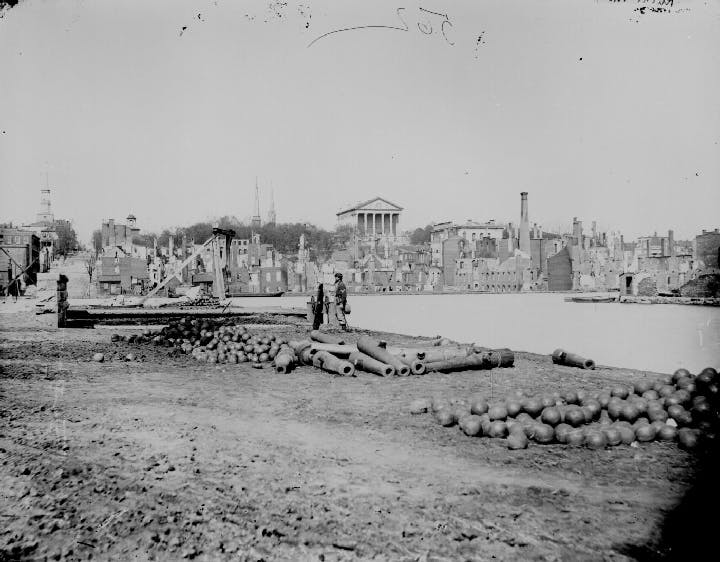Summer 2021
The Road Not Taken
– John Strausbaugh
The Union and the Confederacy talked peace to the bitter end. Why didn’t it happen?
On February 2, 1865, President Abraham Lincoln and his Irish valet sneaked out of Washington City and took a steamboat down to the mouth of the Chesapeake Bay. The next day he met with three representatives of the Confederacy to discuss ending the Civil War. The Hampton Roads Peace Conference, as it's known, is notable not for what was accomplished – nothing was – but for how, when, and why it took place at all.

In February, 1865, the Confederacy was clearly on the brink of collapse. The rebel armies were dogged but much diminished. General William Tecumseh Sherman had sacked Atlanta and was leaving a trail of devastation through Georgia. Ulysses S. Grant had Robert E. Lee pinned down at Petersburg, a rail center that was Richmond's last defense. A Union naval blockade had cut off all supplies. Everyone knew the end was a few months away at best.
With the war all but won, why would Lincoln go out of his way, literally, to parley with the enemy? The simplest answer is that he was looking already to the postwar future, and how best to deal with the insurgents. Many hardliners in his Republican Party and his Cabinet thought they knew the answer: utterly crush the rebels militarily, hang their leaders, free all their slaves, confiscate their other property, and subjugate the South as a conquered, occupied enemy.
Lincoln believed that was no way to heal the nation. With the weight of more than half a million war dead on his soul, he "wanted to end the war quickly, peacefully if possible, not only to save lives, money, and property but also to build a stronger foundation for reconstruction," writes James B. Conroy, author of a detailed book about the conference, Our One Common Country. "If the Confederacy could be persuaded to return to the Union voluntarily, enticed by reasonable concessions, the stage would be set for a more amicable, productive future than a military conquest could produce."
With the war all but won, why would Lincoln go out of his way, literally, to parley with the enemy?
Still, Lincoln maintained some "indispensable conditions" to peace. The insurrectionists must agree to abandon the fiction of a legitimate Confederate States of America and rejoin the Union. And there would be "no backward steps by the chief executive" on slavery.
Lincoln knew that Jefferson Davis would never agree to rejoining the Union. The Confederate president was exhorting Southerners to fight to the last drop of blood, declaring that the Confederacy would have independence "or extermination." But Lincoln also announced that the people of the South "can, at any moment, have peace simply by laying down their arms, and submitting to the National authority under the Constitution." Otherwise, the Union was prepared to "maintain the contest indefinitely."
Gettysburg and Greeley
February 1865 was not the first time Lincoln had entertained peace overtures. Some of the past proposals had been quite outlandish.
In the summer of 1863, Robert E. Lee had invaded the Union, attempting to frighten war-weary Northerners into demanding that Lincoln negotiate an end to hostilities. Confederate Vice President Alexander Stephens headed under a flag of truce to Union-held Fort Monroe at Hampton Roads, prepared to negotiate. Lincoln was willing to go meet him, but Lee's defeat at Gettysburg had the opposite effect on Northern morale. Stephens was turned back unmet.

That same year, Horace Greeley, the flighty founder of the New-York Tribune, got involved in a crackpot scheme to have Queen Victoria or Napoleon III broker peace talks. Famously erratic, probably bipolar, Greeley went from being one of Lincoln's biggest boosters to one of his most aggravating and hectoring critics as the war dragged on.
In July 1864, Greeley heard from a fellow eccentric that "two ambassadors of Davis & Co. are now in Canada, with full and complete powers for a peace." He excitedly dashed off a letter to Lincoln: "Our bleeding, bankrupt, almost dying country longs for peace… I entreat you to submit overtures for pacification to the Southern insurgents."
Lincoln didn’t believe for a second that the "ambassadors" were bona fide, but was reluctant to turn down even an unlikely chance for peace. He directed his aide John Hay to accompany Greeley to Niagara Falls. Hay instantly determined it was a pipe-dream. Lincoln was annoyed but not surprised.
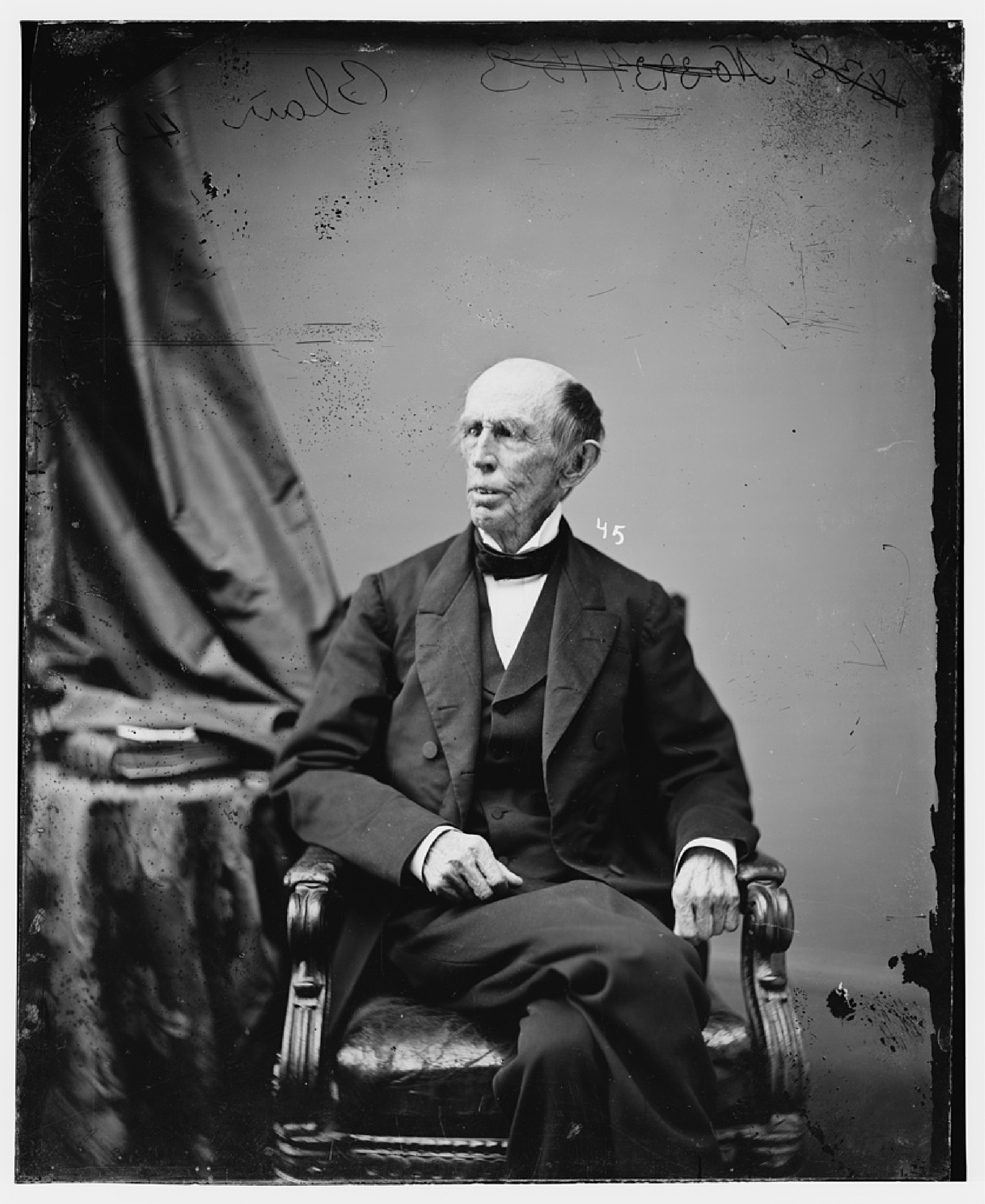
Later that year, privately goaded by Greeley, the newspaper man Francis Preston Blair had a go. "The Old Gentleman" had been advising presidents since Andrew Jackson, and mentored both Lincoln and Davis. He owned an estate outside the city he named Silver Spring, and had resided in the townhouse across Pennsylvania Avenue from the executive mansion for so long that it came to be known as Blair House.
On December 28, 1864, Blair asked Lincoln for a pass through Union lines to go to Richmond. Lincoln approved the pass, but refused to hear his plans; after the Greeley embarrassment, Conroy surmises, the president wanted to maintain what we'd now call plausible deniability.
In Richmond on January 12, 1865, Davis listened politely as Blair described a ludicrous peace plan. In 1861, France had invaded Mexico and established Maximilian I as its emperor, clearly violating the Monroe Doctrine. In Blair's scheme, Lee and Grant would march their combined armies into Mexico and together drive the French out. Their joint victory would surely lead to a happy reunion of North and South.
Lincoln scholar William C. Harris, author of Lincoln's Last Months, writes that Davis had no interest in Blair's scheme, but did send him back to Washington with a letter stating his willingness "to enter into negotiations… with a view to secure peace to the two countries."
Lincoln read this letter and sent Blair shuttling back to Richmond with a letter authorizing him to tell "the insurgent leader" that he was "ready to receive any agent whom he, or any other influential person now resisting the national authority, may informally send to me with a view to securing peace to the people of our one common country."
Harris notes that as long as Davis insisted on "the two countries" and Lincoln on "our one common country," the negotiation was doomed before it started.
Subterfuge and Steamboats
Lincoln's Cabinet shook their heads over the Blair escapade; Gideon Welles, Secretary of the Navy, considered it one of Lincoln's "strange and incomprehensible whims." Nevertheless, it did produce some movement.
The Confederacy’s President summoned his Vice President to him. Alexander "Little Alec" Stephens, slight and sickly, with the withered face of a preternaturally aged boy, had been an outspoken opponent of the war for four years, making himself reviled by the adamantinely hawkish Davis.
Despite the 1863 misfire, Davis now instructed Stephens to lead a three-man commission to Fort Monroe to discuss peace with whomever came to represent the Union. The other commissioners were Judge John A. Campbell and Virginia senator Robert Hunter, who had also been leading voices for peace.
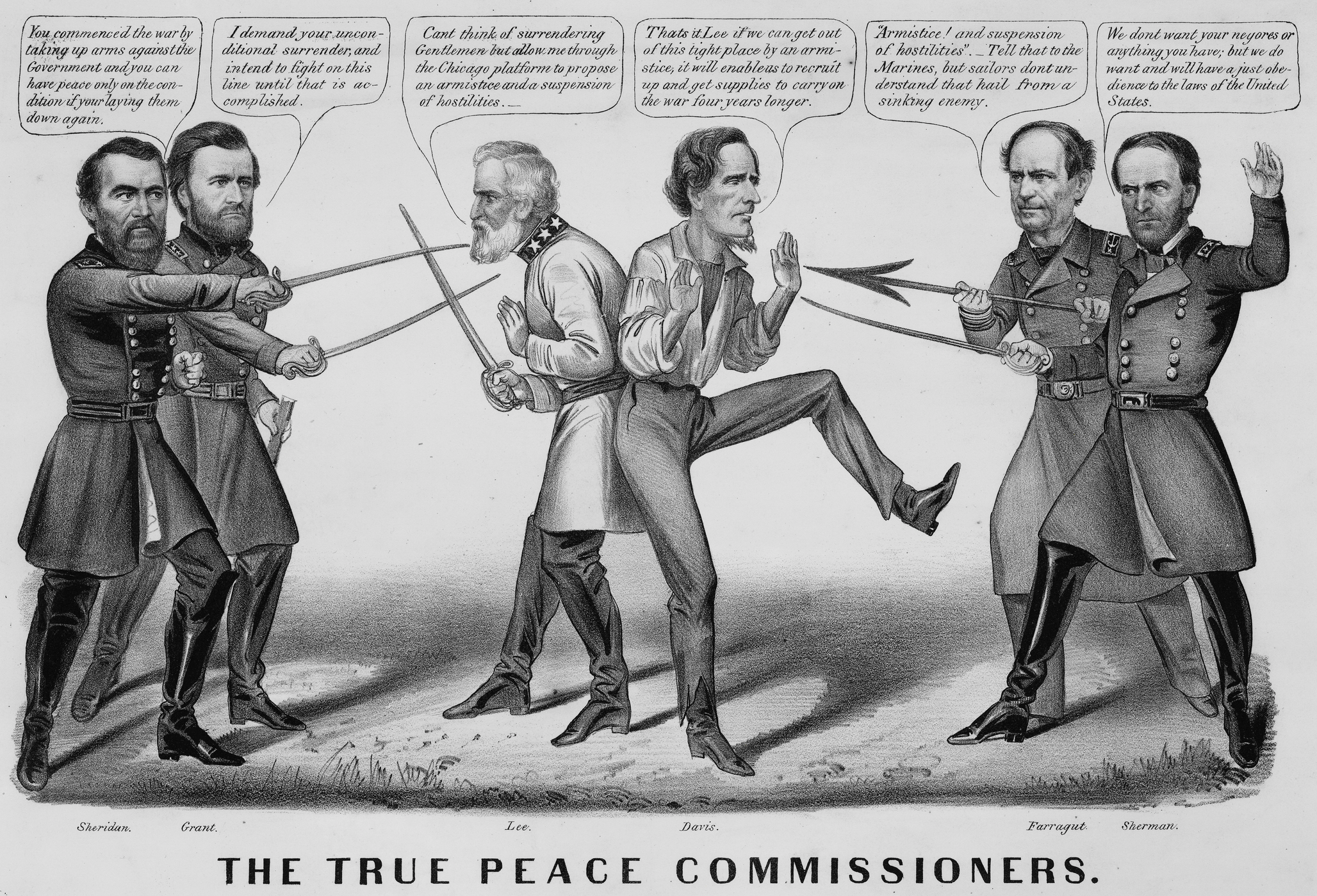
Davis had no high hopes for the mission; if they talked the North into a cease-fire, it would buy him some time to maneuver, and if they failed, they'd bring shame to their peace movement and rekindle Southerners' fortitude for continued combat.
Lincoln sent his Secretary of State William Seward, who had been a shoo-in for the Republican presidential nomination in 1860 before his bitter enemy Greeley and others engineered the rise of the dark horse rail-splitter. Lincoln told Seward to agree to nothing without his authorization.
On January 31, while he was writing these instructions to Seward, the Thirteenth Amendment banning slavery came up for a vote in Congress. It had failed once before, and rumors that Confederate peace commissioners were on their way to Washington could scuttle it again. "Democrats believed that an early peace could not be achieved if the North insisted on emancipation as a condition for negotiations," Harris writes.
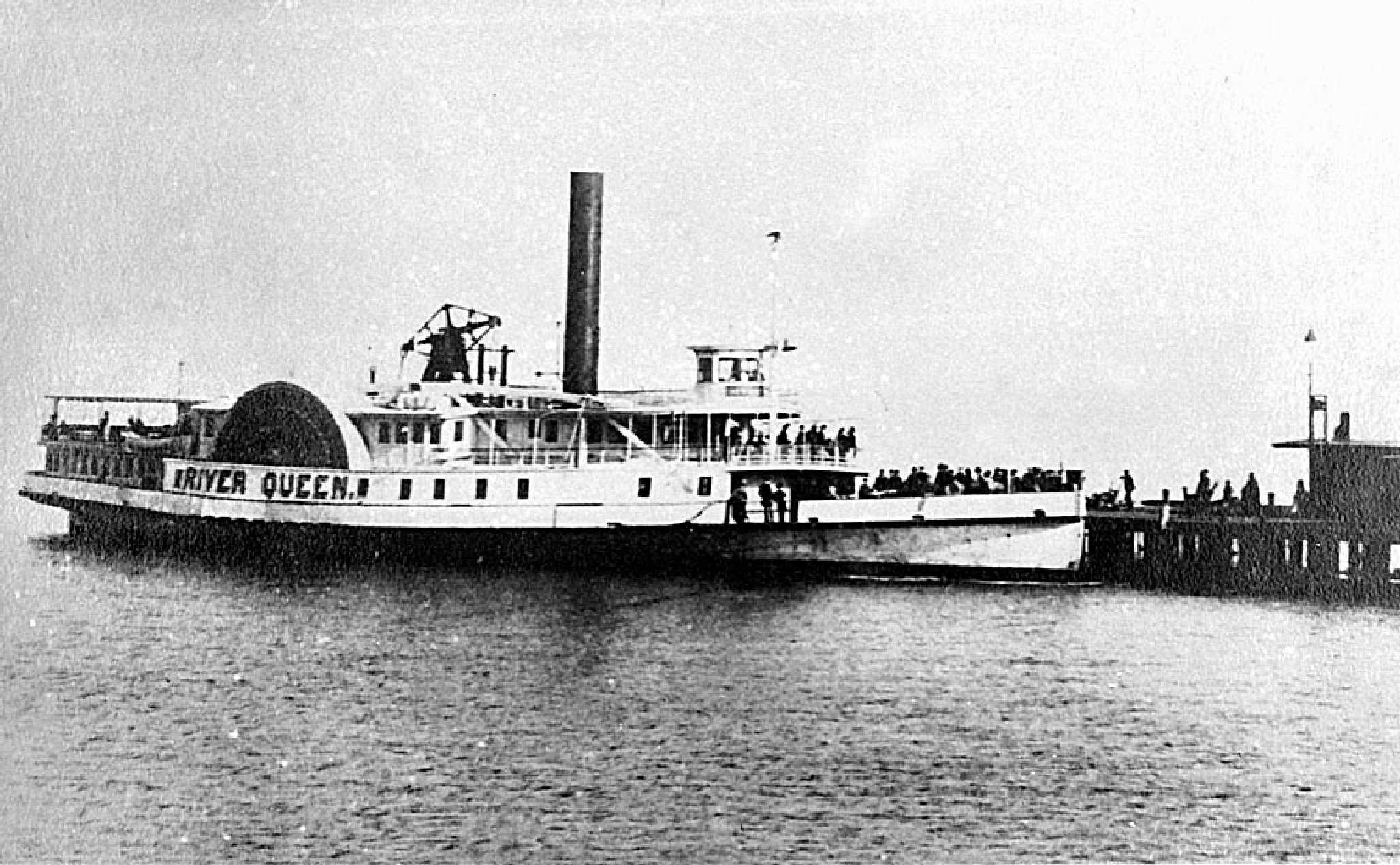
So Lincoln set aside his letter to Seward, took a fresh sheet of paper, and wrote to Congress: "So far as I know, there are no peace commissioners in the city, or likely to be in it." Then he resumed his letter to Seward. The subterfuge worked, and the amendment passed by two votes.
Lincoln decided he should join Seward for the talks after all. He and his valet slipped out of Washington on the morning of February 2. Welles wrote in his diary: "None of the Cabinet were advised of this move, and without exception, I think, it struck them unfavorably…"
Seward awaited the President near Fort Monroe on the River Queen, a gleaming new double-sidewheel steamboat leased from its owner to be the presidential yacht. The Confederate commission arrived on the Mary Martin, a steamboat lent them by General Grant. (No one longed for an end to the fighting more than Grant.)
When the Mary Martin had tied up alongside, Seward sent over three bottles of fine whisky and told them the meeting would happen in the morning. Lincoln joined Seward that night.
Sticks and Carrots
On February 3, Lincoln and Seward met the three Southerners in the River Queen's plush saloon. There were no strangers present. Stephens had been a Whig colleague of Lincoln, protesting the Mexican War in 1848 during the latter's one term in Congress. Campbell had been one of the Supreme Court justices whose Dred Scott decision pushed the nation closer to schism in 1857. And Hunter was a former Speaker of the House.
Lincoln, as was his wont, sought to ease tensions with a rustic joke. Watching the tiny Stephens struggle out of a mammoth woolen coat, he remarked that he had "never seen so small an ear emerge from so much husk." Despite being very sensitive about his birdlike appearance, Stephens laughed.
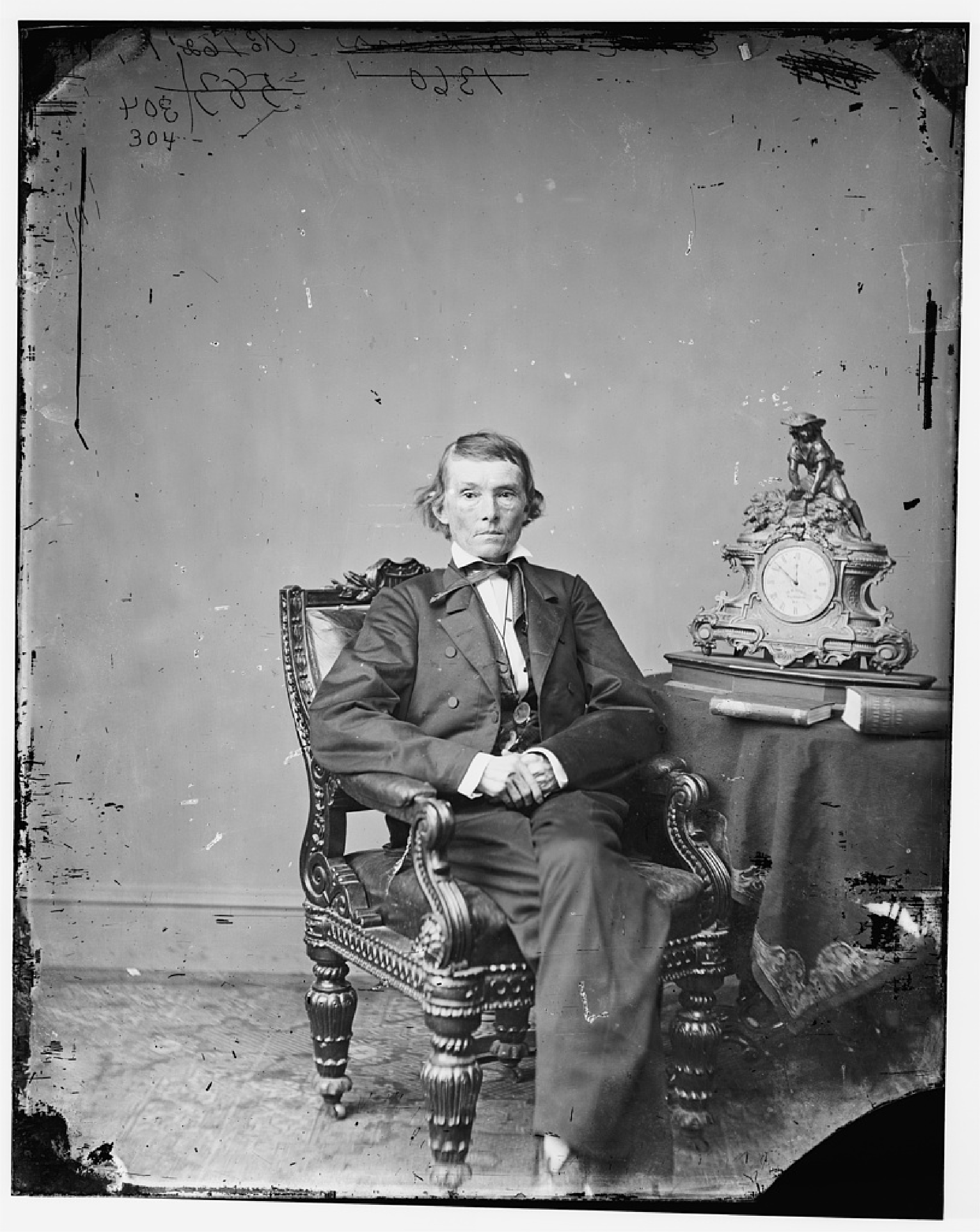
They got down to business and soon filled the saloon with cigar smoke (only the President did not partake). No one took notes; they wrote about the meeting later. Lincoln quickly made it clear that his "indispensable conditions" were still in place. The rebels must cease fighting and agree to rejoin the Union and obey its laws. He would hear none of Davis's guff about a peace between "two nations." There was only one. He also dropped the ominous hint that if the leaders of the rebellion – present company not excluded – chose to fight to the bitter end, he might not be able to restrain hardliners in the Union who insisted on hanging them.
The conference might have ended there, but Lincoln and Seward then offered enticements. If the insurgents did as Lincoln asked, he predicted they'd be welcomed back into the Union with leniency, with their rights restored and their properties intact.
The talk of property led to the issue of slavery. Contrary to much of the mythology that grew up around him later, Lincoln abhorred slavery but was no radical abolitionist. He had never intended to end slavery in the South until the war forced his hand. The Emancipation Proclamation was not a humanitarian gesture, but a strategic tool – an economic and psychological blow against the Confederacy.
Lincoln told the commissioners that what would be done about slavery after the war was up to Congress and the courts more than the president.
"None of the Cabinet were advised of this move, and without exception, I think, it struck them unfavorably…"
Hunter, a slave-owning plantation aristocrat, said that to free all four million Southern slaves at once would be a cruelty, as they had no experience in fending for themselves. Lincoln himself favored a gradual release from bondage, over perhaps five years.
To underscore the sentiment, Lincoln now employed another crude rusticism. It was a joke about a farmer who let his hogs feed by digging up his potatoes; asked what they would do when winter froze the fields, he replied that "it may come pretty hard on their snouts, but in the end it will be 'root hog, or die.'" That is, they'd either learn how to get by or perish.
It was a folk witticism that went back at least to Davy Crockett's day. Seward, who had endured Lincoln's rough-hewn wit in many cabinet meetings, blanched, and even the Southerners thought it surprisingly callous.
Seward offered another incentive, telling the commissioners that Congress had just approved the Thirteenth Amendment. It was now up to the three-fourths of the states to ratify it. If the eleven states of the Confederacy stopped fighting and rejoined the twenty-five in the Union, they'd have enough votes to block it.
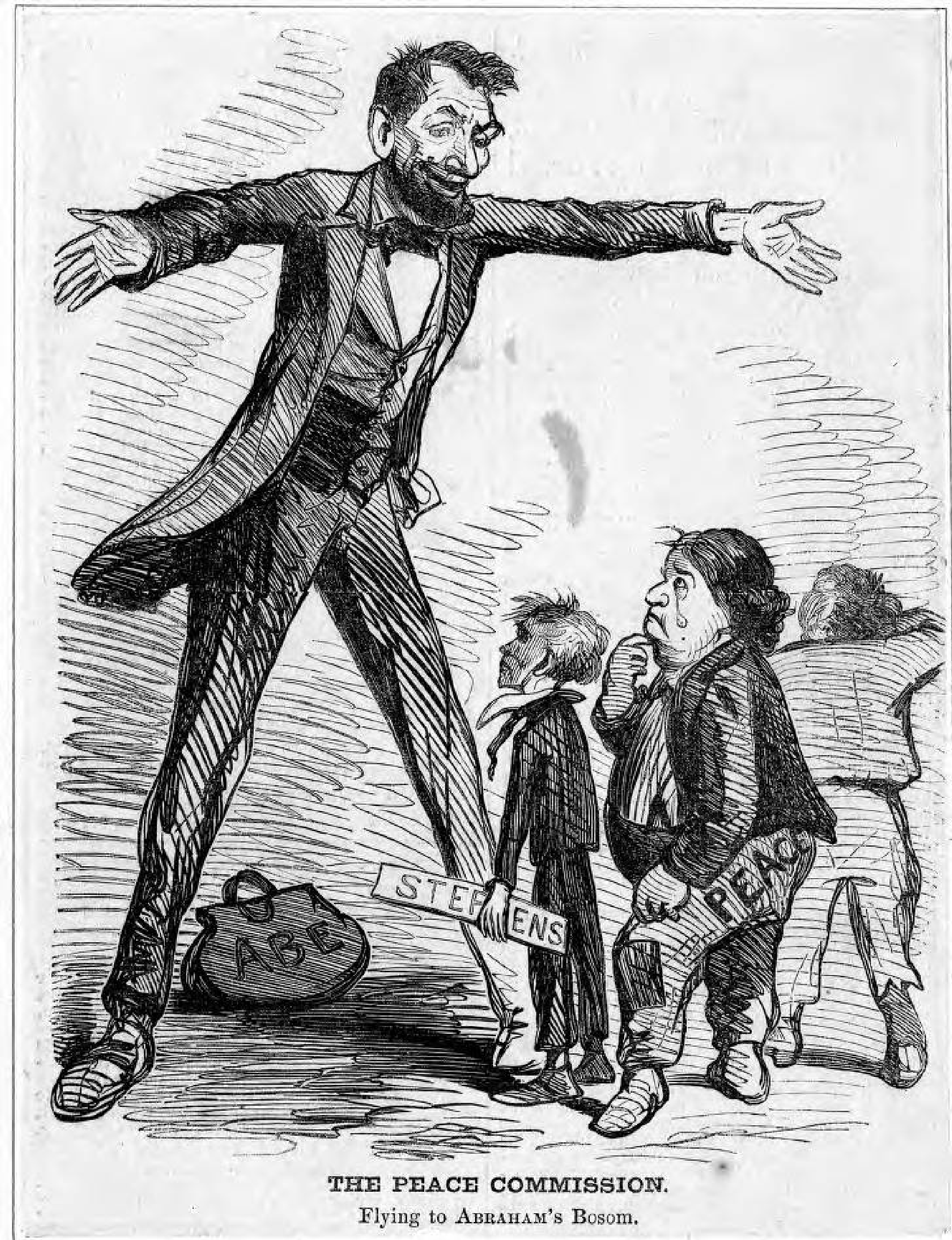
It's maybe no surprise that this exchange is represented very differently in Steven Spielberg's reverential film Lincoln. In that account, it is Stephens who raises the issue of the Thirteenth Amendment. Lincoln replies that its ratification is a fait accompli: "Slavery, sir? It's done." Rather than joking about rooting hogs, he lectures the Southerners on the meaning of democracy.
The actual meeting at Hampton Roads ended with one minor, digressive accomplishment: Lincoln and Stephens agreed that an exchange of prisoners of war should be arranged. Then, after nearly four hours, the two sides cordially parted ways.
Back in Washington, Lincoln told his Cabinet he still had hopes, and outlined a plan to have the federal government compensate slave-owners for the loss of their human property. His Cabinet rejected it outright.
Delusion and Defeat
In Richmond, Jefferson Davis gloated at the failure of Stephens's doves. Three days later, on February 6, he held a thundering rally, ironically at the city's African Church.
The Richmond Dispatch reported that "the greatest concourse of people assembled in that building last evening that ever before were at one time collected under its roof… Never before has the war spirit burned so fiercely and steadily. A firm resolve to resist to the very death the demands of the Northern tyrant that now animates the whole Southern people was plainly visible in that meeting." Davis rejected the demands of "his Majesty, Abraham the First," and called on Southerners to keep fighting until the North was forced to seek peace on Confederate terms.
It was rousing but empty speechmaking. Within less than a month, Lee requested a meeting with Grant to discuss a cease-fire. On March 4, the day of Lincoln's second inauguration, Secretary of War Edwin Stanton ordered Grant to ignore Lee's request and press on.
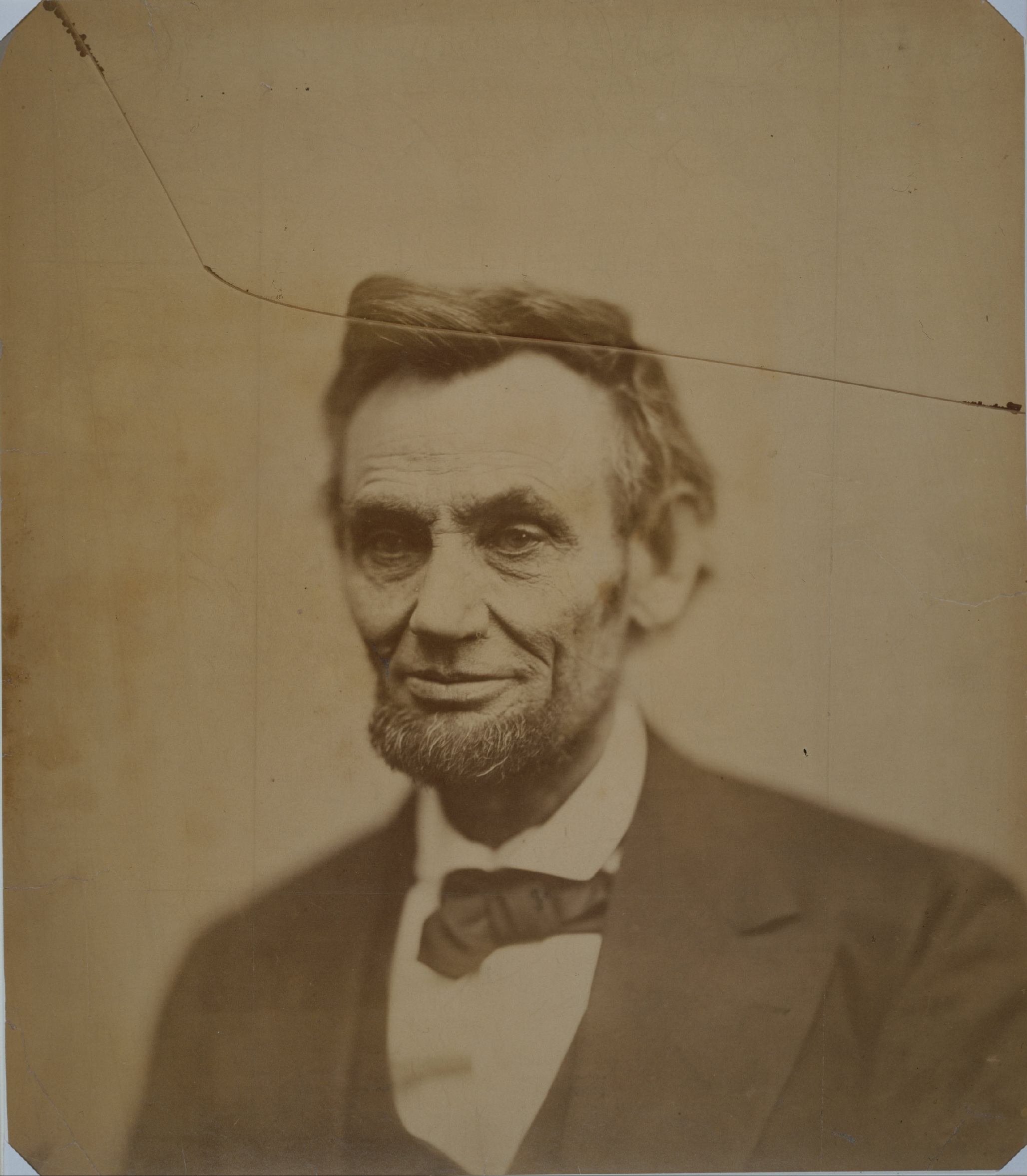
Davis and the tattered remains of his government fled Richmond a month later. When Lincoln toured the smoldering occupied capital on April 4, only Judge Campbell was there to meet with him. Remarkably, the president was still willing to negotiate, but there was no one left to do so.
History was moving quickly to other destinations. Lee surrendered to Grant on April 9. Enraged and despondent over the collapse of the Confederacy, John Wilkes Booth assassinated Lincoln on April 15. Jefferson Davis was captured on May 10. In June, the Union army freed the last slaves in Texas; Juneteenth would become a federal holiday in 2021. The Thirteenth Amendment was ratified in December.
John Strausbaugh is the author of City of Sedition: The History of New York City during the Civil War.
Cover photograph: Matthew Brady's photograph of Richmond in ruins in 1865. (National Archives and Records Administration)
